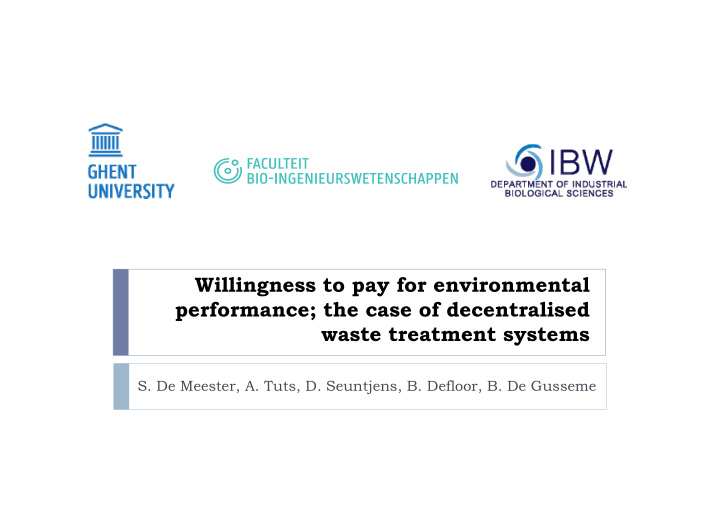



Willingness to pay for environmental performance; the case of decentralised waste treatment systems S. De Meester, A. Tuts, D. Seuntjens, B. Defloor, B. De Gusseme
Who am I? Ghent University Faculty of Bioscience Engineering Department of Green Chemistry and T echnology Topic: “sustainable design of process chains from waste” Assistant professor since 2016 1 postdoc 1 technician Promotor/copromotor of 10 PhD students
Strategy/equipment Designing separation trains towards desired purity for a specific application: Characterisation of product by chemical analysis (IR, GC-MS, HPLC, ICP, …) Basic modeling (ASPEN) Pilot experiments Basic economic/environmental assessment Available unit operations: Distillation (continuous, batch, vacuum, reactive) Membrane treatment (micro/nanofiltration) Adsorption units (ion exchange, active coal, …) Absorption units S/L extraction (used for biomass, but also deinking, …) L/L extraction Hydrocyclones Crystallisation Froth flotation Windshifting Friction washing working volume between 1 to 10 L 3
Two main research topics: plastic waste Plastic waste (Froth) Flotation Cyclones Solvent treatment windshifting Solvent recycling Deodorization/deinking Other sample projects: PROFIT: Bringing the municipal waste refinery to • a next level: Plastic Recuperation and valOrisation FIT for use Plastic product PSYCHE: Conversion of plastic waste to base • chemicals via gasification
Two main research topics Fruit and vegetable waste Precipitation Homogenisation Selective adsorption S/L, L/L Extraction Distillation Affinity & stability testing Other sample projects: Optimisation of the distillation process of fatty • acids from fats ALPO: Specialty polymers from algae Natural dyes/fatty acids • Chemical building blocks
Now on topic: the starting questions Do people “care” about their wastewater treatment? Do they have any preference? How do they value the performance of the treatment system?
Materials & Methods: the case study Centralised WWTS Decentralised WWTS No resource recovery: Constructed wetland With direct resource recovery: ZAWENT
Materials & Methods: Data collection Centralised: WWTP Eindhoven Decentralised: constructed wetland
Materials & Methods: Data collection Centralised: WWTP Eindhoven Decentralised: ZAWENT (Zero AfvalWater met Energie- en NutriëntTerugwinning)
Materials and methods Life Cycle Assessment for environmental performans (Recipe Endpoint H) Life Cycle Costing for economic performance Stated Preference analysis for social aspects and WTP (Qualtrics software) Choice experiments between the options based on Environmental score Cost Participation General opinion based on Likert scale Awareness Aesthetics …
Results: LCA
Results LCC Generally bad data quality For example no ‘overhead’ included in decentralised, whereas it is estimated as almost half of the cost of centralised WWTS ZAWENT not operational yet. Also cost of building excluded Wetlands: way of construction, scale, soil type, … …
Results: stated preference
Results: stated preference This means respondents are willing to pay extra Especially if they can gain profit one day How much?
WTP analysis
Conclusions Decentralised systems seem to perform better related to environmental impact Decentralised systems seem to perform better related to economic cost, but with high uncertainty People value environmental impact Not endlessly + their understanding of environmental impact is not sufficient (they don’t care/know/value if it is 10 or 100% reduction) Potential thesis student bias in the result A combination of sustainability assessment methods is fun
Welcome to contact Prof. dr. ir. Steven De Meester Steven.DeMeester@ugent.be +32472258771
Recommend
More recommend